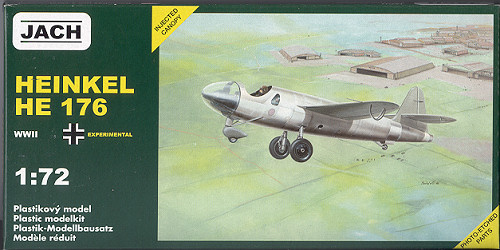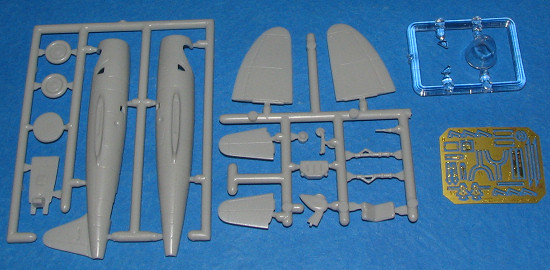
| KIT: | JACH 1/72 He-176 |
| KIT #: | 72102 |
| PRICE: | 1800 yen at www.hlj.com |
| DECALS: | None |
| REVIEWER: | Scott Van Aken |
| NOTES: | Short run with etched parts. |

| HISTORY |
The Heinkel He 176 was the world’s first aircraft to be propelled solely by a liquid-fuelled rocket, making its first powered flight on July 20, 1939 with Erich Warsitz at the controls. It was a private venture by the Heinkel company in accordance with director Ernst Heinkel's emphasis on developing technology for high-speed flight. The performance of the He 176 was not spectacular, but it did provide "proof of concept" for rocket propulsion.
During the 1920s, German daredevils had experimented with using solid-fuel rockets to propel cars, motorcycles, railway carriages, snow sleds, and, by 1929, aircraft such as Alexander Lippisch’s Ente and Fritz von Opel’s RAK.1. Solid-fuel rockets, however, have major disadvantages when used for aircraft propulsion, as their thrust cannot be regulated, and the engines cannot be shut down once fired.
In the late 1930s, Wernher von Braun's rocketry team working at Peenemünde investigated installing liquid-fuelled rockets in aircraft. Heinkel enthusiastically supported their efforts, supplying a Heinkel He 72 and later two Heinkel He 112s for the experiments. In Spring 1937, one of these latter aircraft was flown with its piston engine shut down during flight, at which time it was propelled by rocket power alone. At the same time, Hellmuth Walter's experiments into Hydrogen peroxide-based rockets were leading towards light and simple rockets that appeared well-suited for aircraft installation.
The He 176 was built to utilise one of the new Walter engines. It was a tiny, simple aircraft, built almost entirely out of wood and lacking even an enclosed canopy. It had a conventional, fixed, tricycle undercarriage, but relied on the weight of the pilot to actually rest on its wheels. Empty, the tail of the plane rested on the ground.
Heinkel demonstrated the aircraft to the RLM, but official disinterest led to the abandonment of the company's rocket propulsion programme. The He 176 was placed in the Deutsches Technikmuseum ("German Technical Museum") in Berlin, where it was destroyed in an air raid during World War II.
Prior to the cancellation of the programme, plans had been drawn up for a more sophisticated rocket-plane, still designated He 176. This was never constructed, but because it bore the same designation as the aircraft that was actually flown, many books and websites mistakenly publish pictures of it to illustrate its earlier namesake. Amazingly, there is only one known image of this most important aircraft.
Germany did eventually fly an operational rocket-propelled fighter, the Me 163, but this was made by the competing Messerschmitt firm, using an engine that was a further development of the one that powered the He 176.
Thanks to http://en.wikipedia.org for most of the background info.
| THE KIT |
 JACH are famous in my book for producing kits that fill about 20% of the small boxes in which they are packaged. This one is similar to the Baynes Bat a model I did a year or so ago in that it has to be one of the smallest aircraft kits on my display shelf. I often mistake it for a dust bunny when cleaning the shelves......
JACH are famous in my book for producing kits that fill about 20% of the small boxes in which they are packaged. This one is similar to the Baynes Bat a model I did a year or so ago in that it has to be one of the smallest aircraft kits on my display shelf. I often mistake it for a dust bunny when cleaning the shelves......
This one will join that illustrious grouping with three small sprues, one of them the clear bits. All of the parts are well molded with engraved detailing. I found a sink area on the nose wheel spat and that pretty well covers the glitches. The transparencies are as think as the rest of the plastic (which is rather thick) so it is a good thing this plane had no canopy or you'd not be able to see the interior detail very well. The photo etched fret is well done and makes up all of the detail parts. With a plane this small, lots of detail there isn't, but then the He-176 was a research aircraft and about as bare bones as you can get. Since it is a research aircraft, no markings are provided or needed.
Instructions are quite well done and provide nice drawings that show just where all the various bits are located. What little preliminary painting is required is shown with colors given in generic and RLM designations. This is basically RLM 02 and unpainted metal. The design of things is such that you could probably prepaint most of the airframe parts prior to assembly.
| CONCLUSIONS |
If your penchant is prototype and research aircraft, then this is a kit that you simply must add to your collection. It is well molded and should be a trouble-free build if one takes one's time during construction. For one thing, it will be an interesting comparison if set next to an XB-70!
July 2006
My thanks to  for the review kit. Get yours direct. Save money, buy lots!!
for the review kit. Get yours direct. Save money, buy lots!!
If you would like your product reviewed fairly and fairly quickly by asite that has over 300,000 visitors a month, please contactme or see other details in the